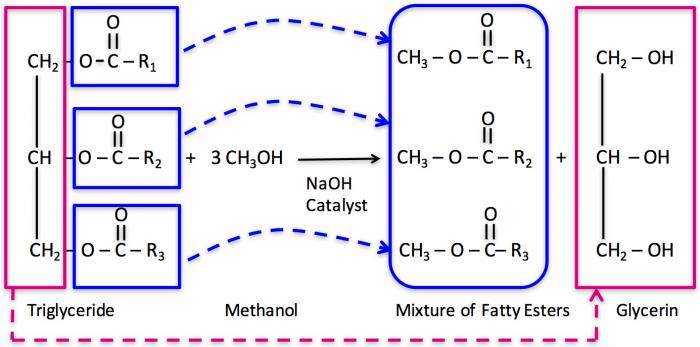Introduction
On the morning of April 20th, 2023, President Joe Biden was joined by ten world leaders at the White House to hold the Major Economies Forum on Energy and Climate in Washington, D.C.1 This annual gathering of world leaders represents a crucial platform for discussing and advancing sustainable policies, such as reducing CO2 emissions to zero by mid-century. In an era where global challenges like climate change, economic instability, and public health crises transcend borders, international cooperation is paramount. However, cooperation on a smaller scale is equally as important in reaching our environmental goals. It is through these small changes that the general population is able to contribute to goals for a better environment.
Biofuels, derived from organic materials such as plant matter, have traditionally relied on crops like corn for production. However, the industry has increasingly turned to more environmentally friendly biofuel sources, most notably, used cooking oil. This transition minimizes competition with food production, reduces concerns about deforestation and land use change, and offers a more environmentally friendly and energy-efficient approach, achieved by a comparatively low carbon footprint.

Emergence of Biofuels
The emergence of biofuels as an alternative energy source marked an initial stride toward mitigating the environmental impact of conventional fossil fuels. With pollution levels rising significantly across the globe, commercial gasoline as fuel for transportation has significantly hindered clean energy initiatives. While utilizing biofuels was initially considered a promising solution, the widespread reliance on corn-based ethanol and biodiesel has its own negative consequences. This includes high water use, competition with food crops, and limited greenhouse gas emission reductions. Deriving from plants does not give biofuels the carbon neutral stamp, as it still contributes to rising pollution levels. Standard gasoline carries a CO2 emission level of 8,887 grams of CO2 per gallon while biofuels release 2,661 grams per gallon.3,4 Although a decrease is visible, climate change has become too significant of an issue—in order to avoid the worst of global warming humans must get to net-zero carbon emissions by the year 2050.5 In response, scientists and researchers have been exploring diverse avenues to make biofuels more sustainable. This includes utilizing advanced biotechnologies like genetic engineering to enhance the efficiency of microorganisms involved in biofuel production, as well as focusing on the cultivation of non-food crops, algae, and even municipal waste as feedstocks. Additionally, advancements in production techniques, such as the development of more efficient enzyme catalysts and the utilization of carbon capture and utilization (CCU) technologies, are being explored. These innovations represent a multifaceted approach aimed at achieving a balance between biofuel production and environmental sustainability, thereby paving the way for a greener and more responsible energy future.

The Chemical Process
The process of converting cooking oil into biodiesel is a simple but highly productive endeavor. It requires four key reagents: cooking oil (typically vegetable oil), methanol or ethanol (the alcohols), water, and a catalyst (often sodium or potassium hydroxide). A catalyst is a substance that facilitates or speeds up a chemical reaction without undergoing any permanent change itself during the process. In other words, a catalyst increases the rate at which a chemical reaction occurs but does not get consumed or altered in the reaction.
The process begins with collecting and purifying cooking oil, which involves a rigorous filtration process to remove impurities and food particles that would otherwise interfere with the biodiesel reaction. This step is crucial to prevent damage to the equipment and to ensure the quality of the biodiesel.
After the oil is filtered, the transesterification process begins where the cooking oil is mixed with alcohol and a catalyst. This chemical process converts the oil into a solution containing biodiesel fuel and glycerin. The mixture is heated and stirred to promote the reaction. The catalyst helps break the ester bonds in the triglycerides found in the cooking oil. The triglycerides in the cooking oil react with the alcohol and catalyst to form biodiesel (methyl or ethyl esters) and glycerin. The reaction can be represented as follows: Triglyceride + 3 Alcohol → 3 Biodiesel + Glycerin. From this step, the solution is allowed to cool so that it can undergo separation. This occurs because the glycerin settles at the bottom while the biodiesel floats on top, since glycerin is denser and less fatty than biodiesel.
With the two layers separated, the sample can now undergo the washing and purification step where water removes (or washes away) impurities, such as residual alcohol, catalyst, and glycerin, a byproduct of the reaction. Multiple washings and water separation steps may be required to ensure a high-quality product. The resulting biodiesel is rigorously tested to meet industry standards for quality and performance. This testing examines the composition of the biofuel sample, determining if contaminants leading up to more ash or sulfur production upon combustion—which would decrease the quality of the biofuel—are present. This ensures that the product meets the necessary specifications for use in diesel engines. After this meticulous process, the fuel finally qualifies as a biodiesel, which can be used as a renewable and more environmentally friendly alternative to conventional diesel fuel.
The Benefits
By repurposing cooking oil into biodiesel, scientists significantly reduce the environmental impact of cooking oil waste by recycling it and reducing the consumption of fossil fuels. This approach minimizes waste sent to landfills and lowers the risk of oil pollution in local waterways. Every year, 200 million gallons of used oil are improperly disposed of, and the practice of converting used cooking oil to create biofuels eliminates this issue.6 However, the sustainability of this process is constantly reviewed by researchers. Commercial biodiesel has a history of being questioned on the scale of its positive impacts, especially because it causes a food shortage effect that results from deriving biodiesel from corn. Costs also become an issue, making commercial biodiesel unstable for the average driver. But deriving biodiesel from used cooking oil is found to overcome these setbacks, as detailed by authors Mangesh G. Kulkarni and Ajay K. Dalai: “A major hurdle in the commercialization of biodiesel from virgin oil, in comparison to petroleum-based diesel fuel, is its cost of manufacturing, primarily the raw material cost. Used cooking oil is one of the economical sources for biodiesel production.” 7
At UC Berkeley, biodiesel production is being used by the Biofuels Technology Club to provide a unique learning opportunity for students and researchers. This collaborative effort promotes sustainable practices beyond the campus boundaries.

The Future
The production of biofuels offers a promising avenue to reduce our reliance on fossil fuels and mitigate the environmental impacts associated with their use. However, the adoption of biofuels comes with its own set of challenges. One of the primary challenges is ensuring a stable and sustainable supply of feedstock, such as cooking oil, which serves as a crucial raw material in the biofuel production process. Sourcing an adequate and consistent supply of cooking oil presents logistical and economic hurdles that must be overcome to make biofuels a viable alternative. Additionally, the environmental benefits of biofuels are contingent on responsible sourcing and production practices. On a positive note, biofuels have the potential to significantly reduce greenhouse gas emissions and contribute to a cleaner and more sustainable energy future. According to the International Energy Agency (IEA), the use of biofuels could potentially lead to a 27% reduction in CO2 emissions from the transport sector by 2050, contributing to a healthier planet for future generations. It is essential that we address these challenges and harness the full potential of biofuels to transition towards a greener and more sustainable energy landscape.
Conclusion
While global consensus on ambitious emissions reduction goals may be a complex endeavor, it is heartening to recognize that smaller communities and local initiatives can still play a pivotal role in effecting positive change for the environment. Creative thinking, resourcefulness, and community-driven efforts are proving to be powerful tools in the fight against climate change. Biofuels, such as biodiesel, are already making a difference today by offering a more sustainable alternative to conventional fossil fuels. In various regions, biodiesel is being utilized in transportation, agriculture, and industry, reducing carbon emissions and helping communities take meaningful steps toward a greener future. It’s a reminder that even on a smaller scale, collective actions can contribute to a larger, global effort to address climate challenges and create a more sustainable and resilient world.
Acknowledgments
Thank you to Dr. Michelle Douskey and her husband for their contributions and review.
Sources
- The United States Government. (2023, April 26). Chair’s summary of the major economies forum on energy and climate held by president Joe Biden. The White House. https://www.whitehouse.gov/briefing-room/statements-releases/2023/04/21/chairs-summary-of-the-major-economies-forum-on-energy-and-climate-held-by-president-joe-biden-2/#:~:text=On%20 April%2020%2C%202023%2C%20 President,limit%20on%20 warning%20 within%20 reach
- Hazardous air pollutants: Sources and exposure | US EPA. (n.d.). https://www.epa.gov/haps/hazardous-air-pollutants-sources-and-exposure
- Greenhouse gas emissions from a typical passenger vehicle. Greenhouse Gas Emissions from a Typical Passenger Vehicle. (n.d.). https://www.epa.gov/greenvehicles/greenhouse-gas-emissions-typical-passenger-vehicle .
- Greenhouse gas emissions from a typical passenger vehicle. (n.d.). https://www.epa.gov/greenvehicles/greenhouse-gas-emissions-typical-passenger-vehicle
- Climate change: Frequently asked questions. The Nature Conservancy. (2018, December 9). https://www.nature.org/en-us/what-we-do/our-priorities/tackle-climate-change/climate-change-stories/climate-change-frequently-asked-questions/#:~:text=Every%20watt%20that%20we%20can,emissions%20no%20later%20than%202050
- Environmental Protection Agency. (n.d.). Basic information about used oil. EPA. https://archive.epa.gov/wastes/conserve/materials/usedoil/web/html/oil.html#:~:text=Two%20hundred%20million%20gallons%20of,household%20for%20almost%2024%20hours
- Kulkarni, Mangesh G., and Ajay K. Dalai. “Waste Cooking OilAn Economical Source for Biodiesel: A Review.” Industrial & Engineering Chemistry Research, vol. 45, no. 9, Apr. 2006, pp. 2901–2913, https://doi.org/10.1021/ie0510526. Accessed 2 Jan. 2021.
Image References
Banner Image: CDC Images, C. (2020). Person holding clear glass bottle. Unsplash.com. https://docs.google.com/presentation/d/1lcGtXlmhqTzrFymvirptqqAOPC6_ULFli5gBZI6gSKI/edit?usp=sharing. Retrieved October 1, 2023, from https://unsplash.com/photos/wCo9UwZEa18.
Figure 1: Hazy sunset on the city, London [picture]. (2019). callmefred.com. https://unsplash.com/photos/uDLtqbbVR4I
Figure 2: Chemistry of biodiesel production. [infographic]. John A. Dutton Institute of Teaching and Learning, Penn State. https://www.e-education.psu.edu/egee439/node/684
Figure 3: Akyurt, E. (2022). A row of gas pumps filled with gas [picture]. Unsplash.com. https://unsplash.com/photos/nipgFe8mWB8
